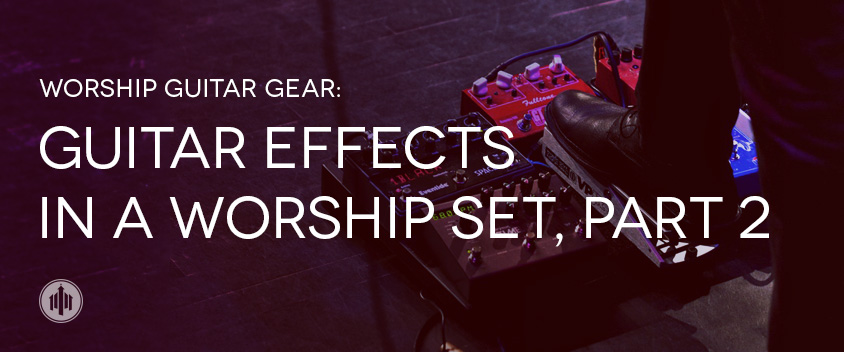
In our last discussion, we talked about how important guitar effects are becoming in our worship sets. Even more so, the proper use of them could make or break the set. We started off by talking about the dry effects. The clean tone, compression and drives. We expressed the importance of the clean tone as it is the foundation of everything to come after it. This principal still holds true when dealing with the wet effects. Delays and Reverbs.
A lot of the guitar sounds we hear in current worship songs are very ambient. This means lots of reverb and lots of delay. Its great to have a nice foundational sound, but being so dry can really put a damper on the song. Reverb and delay can be some great tools you can use to liven up your sound and add space and dimension to your playing.
Speaking as an effect, I like to play the line between using it to complement certain aspects of the song, and using it as a tool to make my part more noticeable. Of course this all depends on the nature of the song. But theres something to be said about a delay that fills the gaps, and a reverb that lingers for days. The line between the two is something you’ll need to play with. But here are some tips on how to achieve both.
PLACEMENT:
Placement is everything. I know people can argue back and forth on this subject, but I like my rule the best. If it sounds good, thats where it goes! Some people put effects at the end, and honestly, thats where mine are. But sometimes you just need to throw an extra delay in before and after your volume pedal. Different placement equals different sounds. I encourage you to experiment and see what you can come up with.
DELAY TIMING:
Of course we are all familiar with the infamous dotted eighth note delay. Its more of a standard setting in todays worship songs. However, there are many other settings that can have just as great of an effect. Quarter notes are easy and simple. They fill the gaps when necessary and add a full richness sound to your tone. Its a nice easy setting to depend. For us Timeline users, there are many other options. So many that we may not know what to do with. When it comes to delay, stick to the standards, don’t over do it and you can never fail.
REVERB:
This is a touchy one for me. Is it too much or not enough? Do I really need more than one? Reverb is an effect best used in moderation, then best used in excess but on separate occasions. I prefer to have two reverb pedals. One that enhances my dry sound to something with a little bit of space. Just so it doesn’t sound so dull. This, like your delay, can add a nice fullness about your sound. However, when the song calls for it, I turn on another reverb pedal thats set at a much longer and louder setting to create an ambience and allow the notes to really linger. This is great so swells and even when the guitar has to carry the song in a quiet section.
All in all, the wet effects are something that really need to be fine tuned. If not, it can be a crazy mess. And who wants that? In our next discussion, we will look at examples of these in video tutorials so you can really get a grasp on the concept. In the meantime, here are some great pedals to help when choosing what to use.
DELAY:
REVERB:

